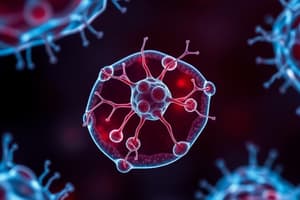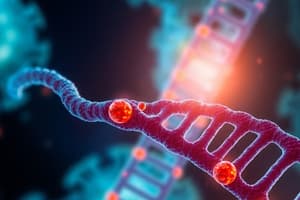Podcast
Questions and Answers
What is the primary function of the central nervous system concerning sensory information?
What is the primary function of the central nervous system concerning sensory information?
- To disregard sensory inputs in order to maintain internal stability.
- To amplify all sensory inputs, ensuring maximum awareness.
- To analyze sensory information and formulate appropriate responses. (correct)
- To store sensory information indefinitely without processing it.
The folding of the brain into gyri and sulci serves what main purpose?
The folding of the brain into gyri and sulci serves what main purpose?
- To separate distinct functional areas of the brain into discrete compartments.
- To facilitate blood flow to different regions of the brain.
- To increase the surface area available for cortical neurons, enhancing processing capacity. (correct)
- To protect the brain from physical trauma by providing cushioning.
Which of the following functions is NOT primarily associated with the medulla?
Which of the following functions is NOT primarily associated with the medulla?
- Maintenance of posture. (correct)
- Regulation of heart rate.
- Regulation of vomiting.
- Control of breathing.
Damage to the superior colliculus would most likely result in difficulties with which function?
Damage to the superior colliculus would most likely result in difficulties with which function?
What would be the most likely effect of a malfunction preventing the substantia nigra from producing sufficient dopamine?
What would be the most likely effect of a malfunction preventing the substantia nigra from producing sufficient dopamine?
Which of the following structures is NOT part of the brainstem?
Which of the following structures is NOT part of the brainstem?
Which structure is primarily responsible for relaying auditory and visual information?
Which structure is primarily responsible for relaying auditory and visual information?
What is the primary function of the basal ganglia?
What is the primary function of the basal ganglia?
Which of the following accurately describes the functional relationship between the central nervous system (CNS) and the peripheral nervous system (PNS)?
Which of the following accurately describes the functional relationship between the central nervous system (CNS) and the peripheral nervous system (PNS)?
A patient has suffered damage to a spinal nerve, resulting in a loss of sensation in their left arm and an inability to move their left hand. Which of the following best explains this phenomenon?
A patient has suffered damage to a spinal nerve, resulting in a loss of sensation in their left arm and an inability to move their left hand. Which of the following best explains this phenomenon?
During a stressful situation, the sympathetic nervous system (SANS) is activated. How does this system influence bladder function to help the body cope with stress?
During a stressful situation, the sympathetic nervous system (SANS) is activated. How does this system influence bladder function to help the body cope with stress?
Consider a scenario where an individual unexpectedly touches a hot stove. Which of the following is the most accurate description of the initial neural pathway involved in the reflex response before the brain perceives pain?
Consider a scenario where an individual unexpectedly touches a hot stove. Which of the following is the most accurate description of the initial neural pathway involved in the reflex response before the brain perceives pain?
In a 'fight or flight' response, which physiological change is directly mediated by the nervous system's control of the adrenal glands?
In a 'fight or flight' response, which physiological change is directly mediated by the nervous system's control of the adrenal glands?
A person experiences vasodilation in their genitals. According to the content, which part of the autonomic nervous system is most likely responsible for this?
A person experiences vasodilation in their genitals. According to the content, which part of the autonomic nervous system is most likely responsible for this?
If the efferent nerve of a spinal nerve pair is damaged, what is the likely outcome?
If the efferent nerve of a spinal nerve pair is damaged, what is the likely outcome?
How does the autonomic nervous system coordinate the functions of urination and urine storage?
How does the autonomic nervous system coordinate the functions of urination and urine storage?
Flashcards
Nervous System Functions
Nervous System Functions
Detects stimuli, recognizes their significance, makes decisions, and executes appropriate responses.
Peripheral Nervous System (PNS)
Peripheral Nervous System (PNS)
Detects environmental stimuli, transmits information to the CNS, and carries out orders from the CNS.
Central Nervous System (CNS)
Central Nervous System (CNS)
Receives & analyzes information, makes executive decisions, and transmits decisions back to the PNS.
Somatic Nervous System
Somatic Nervous System
Signup and view all the flashcards
Afferent Nerves
Afferent Nerves
Signup and view all the flashcards
Efferent Nerves
Efferent Nerves
Signup and view all the flashcards
PNS Nerves
PNS Nerves
Signup and view all the flashcards
Spinal Cord Function
Spinal Cord Function
Signup and view all the flashcards
Gyri and Sulci
Gyri and Sulci
Signup and view all the flashcards
Pons
Pons
Signup and view all the flashcards
Cerebellum
Cerebellum
Signup and view all the flashcards
Medulla
Medulla
Signup and view all the flashcards
Superior Colliculus
Superior Colliculus
Signup and view all the flashcards
Thalamus
Thalamus
Signup and view all the flashcards
Limbic System
Limbic System
Signup and view all the flashcards
Study Notes
The Nervous System
- Under control of the Nervous System is every function of the human body
- The functions of the nervous system include detecting stimuli in the environment before recognizing how important external stimuli are
- Nervous sustem also helps making decisions based on how significant something is and executing a response
Major Divisions
- The Peripheral Nervous System (PNS) aims to detect environmental stimuli and transmit information to the CNS (Central Nervous System)
- The PNS carries out orders that CNS gives
- The CNS's function is to receive and analyze incoming information
- The CNS also makes executive decisions and transmits decisions back to the PNS
Peripheral Nervous System
- The Somatic Nervous System is part of the peripheral nervous system
- Afferent nerves carry information from sensory neurons to the CNS
- Efferent nerves carry information from the CNS to motor neurons
- Nerves come in pairs, with one efferent/motor nerve & the other afferent/sensory nerve
- There are 31 pairs of spinal nerves
- There are 12 pairs of cranial nerves
PNS: Cranial Nerves (12 pairs)
- Olfactory (I): Sensory nerve associated with the nose
- Optic (II): Sensory nerve associated with the eye
- Oculomotor (III): Motor nerve that controls all eye muscles except those controlled by IV & VI
- Trochlear (IV): Motor nerve that controls the superior oblique muscle
- Trigeminal (V): Sensory nerve for the face, sinuses and teeth, also a motor nerve for muscles of mastication
- Abducent (VI): Motor nerve for the external rectus muscle
- Facial (VII): Motor nerve that controls muscles of the face
- Vestibulocochlear (VIII): Sensory nerve for the inner ear
- Glossopharyngeal (IX): Motor nerve for pharyngeal musculature also sensory nerve for posterior part of the tongue, tonsil and pharynx
- Vagus (X): Motor nerve for the heart, lungs, bronchi, gastrointestinal tract also it is a sensory nerve for the heart, lungs, bronchi, trachea, larynx, pharynx and gastrointestinal tract plus the external ear
- Accessory (XI): Motor nerve that controls the sternocleidomastoid and trapezius muscles
- Hypoglossal (XII): Motor nerve responsible for muscles of the tongue
PNS: Spinal Nerves (31 pairs)
- Gray matter, dorsal horn and visceral/somatic sensory nuclei are present
- Ventral and lateral horns exist
- The dorsal root ganglion exists
- Afferent nerves control sensory information
- Autonomic nerves exist for muscle control and glands via the ventral root
Autonomic Nervous System
- The cervical nerves are largely responsible for somatic motor control and sensory function within the neck, shoulders, arms, and diaphragm
- Sexual functions can include the fact tha PANS initially promotes erection (vasodilation), and followed by SANS which then controls ejaculation and vaginal contraction during orgasm (vasoconstriction)
- Timing is ensured, for everything, by SANS
- Regarding bladder function, PANS contracts to allow urination and SANS relaxes the bladder sphincter for urine storage
Components of the Reflex Arc
- Reflex arc components: receptors > afferent pathway > integrating center > efferent pathway > effector
- Pain activates thermal pain receptors in the finger
- Action potentials are generated in the afferent pathways
- Impulses move towards the spinal cord
- The spinal cord is the integrating center where the afferent neuron stimulates: excitatory interneurons stimulate motor neurons to the bicep, inhibitory interneurons inhibit motor neurons to the triceps, and interneurons are then sent to the brain
- Efferent pathways cause the biceps to contract or triceps to relax preventing excitation/traction of antagonistic muscles
- Biceps & triceps are effectors and the movement/flex of an elbow joint withdraws from the painful stimuli
- Events that occur due to the arrival of a signal in the brain via the ascending pathway are separate from the reflex arc, these include memory
Central Nervous System
- The spinal cord is located in the vertebrate spinal column
- Limited analysis and decision making occur int he spinal cord
- The spinal cord transmits information to and from the main
- The brain is in the skull
- It analyzes sensory information and creates appropriate responses
Central Nervous System: The Brain
- The brain weighs 1400 grams which is about 2% of the average body weight
- The brain's structure is folded into gyri (hills) and sulci (valleys)
Hindbrain (Rhombencephalon)
- Metencephalon can also be called the pons: sensory relay
- Cerebellum: maintains posture, timing and planning movements
- Myelencephalon can also be called the Medulla: control basic life functions like breathing, heart rate, vomiting, etc
- Medulla is located in the reticular formation which involves arousal/sleep regulations
Midbrain (Mesencephalon)
- Tectum: contains the superior colliculus which controls eye movements, and the inferior colliculus handles any auditory information
- Tegmentum: has reticular formation, substantia nigra releases dopamine and red nucleus which controls body movements
Brainstem
- The brainstem consists of the hindbrain (metencephalon & myelencephalon) and the midbrain (mesencephalon)
Diencephalon
- Thalamus as part of a central relay station:
- Lateral Geniculate Nucleus (LGN): visual processing
- Medial Geniculate Nucleus (MGN): auditory processing
- Hypothalamus: involved in homeostatic control
- Pituitary gland: Involved in hormonal control (master gland)
- Pineal gland: releases melatonin and is involved in sleep-wake cycle
Telencephalon I: Limbic System
- The limbic system governs emotions (anger, happiness, fear) and it is involved in storage/retrieval of memories
- This includes the Hippocampus and Amygdala
Telencephalon II: Basal Ganglia
- Basal ganglia contains widespread connection to the cortex and forebrain plus it is involved ini voluntary movements with maintenence of muscles, tone and posture
- Contains the caudate nucleus, putamen, and the globus pallidus
- Caudate nucleus and putamen are the striatum
Telencephalon III: Neocortex
- Occipital Lobe's primary function is to analyse visual information
- Parietal Lobe processes sensory information and is involved in spatial perception
- Temporal Lobe processes auditory information and language (Wernicke's area)
- Frontal Lobe controls motor programs, complex intellectual functioning, speech production (Broca's area), personality and executive function
Cortical Homunculus
- Somatosensory and motor cortices have a physical representation of the body
The Ventricular System
- Two views of ventricles, filled with cerebrospinal fluid
- Components: lateral ventricle, interventricular foramen, third ventricle, aqueduct of midbrain and fourth ventricle
The Vascular System
- Approximately 400 miles of blood vessels are in the human body
- Components of the vascular system include anterior cerebral, middle cerebral, posterior cerebral, basilar, vertebral, pontine, superior cerebellar etc
Studying That Suits You
Use AI to generate personalized quizzes and flashcards to suit your learning preferences.




